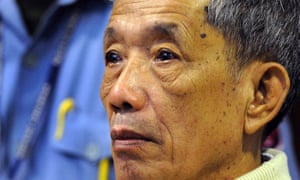
Khmer Rouge torturer Kang Kek Lew on trial. ‘Asked whether he believed the information he obtained through torture was accurate, he responded that he did not,’ writes Alexandre Prezanti. Photograph: Reuters
Letters
Friday 27 January 2017
Guardian
President Trump says of torture that he “absolutely feel[s] that it works”, and that it will keep his “country safe” (Report, 27 January). There are many things to say against torture: it’s cruel, inhumane, traumatic and likely to lead to global outrage and revenge attacks. Moreover, the accuracy of information obtained through it is so poor, that it’s completely unreliable. But don’t just take it from me. A Khmer Rouge, Kang Kek Lew, was accused, and later convicted by a UN war crimes tribunal of being the head of an interrogation centre known as S-21, where over 12,000 people were tortured and killed. During his trial, he was asked whether he believed that the information he obtained through torture was accurate. He unequivocally responded that he did not. His orders were to reveal enemy networks. His victims would name anyone they could think of, just to put an end to the suffering. One young westerner named Colonel Sanders as his alleged superior in the CIA. Some prisoners confessed to being simultaneously agents of the CIA and the KGB.
Torture does not work, unless of course the intended effect is punishment rather than uncovering information vital to saving lives. It may fill the vacant cells at Guantánamo Bay, but it will never make America safe again.
Alexandre Prezanti
Partner, Global Diligence LLP
• I write Medico legal reports for the immigration courts describing the physical and mental states of asylum seekers who claim to have been tortured in their own countries. I have seen 165 Tamils from Sri Lanka. Among my cases was a young Tamil man who had been forcibly recruited to the LTTE (Tamil Tigers). At the end of the civil war (May 2009) he was forced to go to a camp for displaced persons, along with thousands of civilians and LTTE members. The authorities were keen to separate all the LTTE members from the civilians and they tortured the suspected LTTE members to reveal others who were then taken away for “rehabilitation”.
My patient told me that his torture had been extremely bad. His torturers told him that they would stop maltreating him if he would point out other members from his LTTE group. They put a hood over his head with eye holes and took him to a room full of young Tamil men. He did not recognise anyone. He was so desperate to have the torture stopped that he pointed out a young man at random. This young man was arrested immediately and taken away. My patient is full of remorse to this day.
I make the point that torture does not work. What it does do is completely destroy the lives of the tortured – most will not recover for a long time, if ever.
Dr Charmian Goldwyn
London
• President Trump is apparently unaware of the long and dishonourable history of waterboarding. After the second world war, Japanese military officials who had used similar torture techniques on allied troops were successfully prosecuted – by the Americans.
Phil Bramall
Nottingham

No comments:
Post a Comment